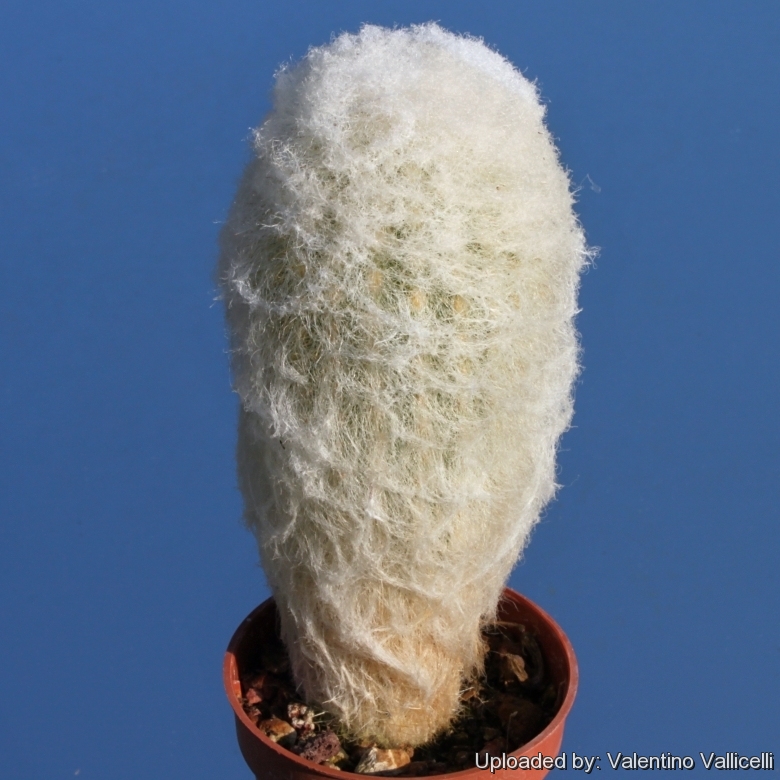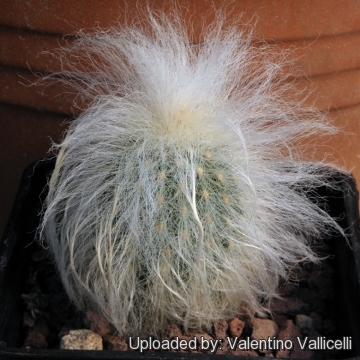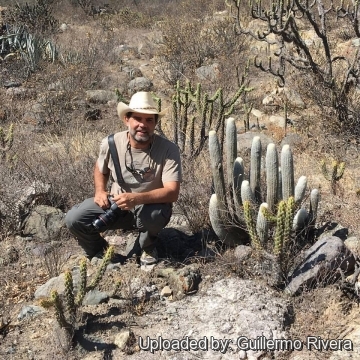
Espostoa melanostele subs. nana Photo by: Valentino Vallicelli
Origin and Habitat: Huallanca, Ancash (Peru, Western South America, Southern America)
Synonyms:
See all synonyms of Espostoa melanostele
back
Accepted name in llifle Database:Espostoa melanostele subs. nana (F.Ritter) G.J.CharlesCactaceae Consensus Init. 14: 15. 2002 [Oct 2002]Synonymy: 3
Accepted name in llifle Database:Espostoa melanostele (Vaupel) BorgCacti (Borg) 112 (1937); vide Gray Herb. Card Cat.Synonymy: 13
back
Description: Espostoa nanaSN|5675]]SN|18796]] (= Espostoa melanosteleSN|5675]]SN|5675]] subsp. nana) is a columnar cactus densely covered with white hair which distinguishes from the standard Espostoa melanosteleSN|5675]]SN|5675]] for its smaller stems and the wool on the cephallum is white to pale yellow (mostly yellow-brown in Espostoa melanosteleSN|18796]]SN|5675]]).
Habit: It is an attractive tall, greyish-green columnar cactus with much apical spination and pubescence.
Habit: Shrub-like reaching 1,5 m in height branching basally.
Stems: Cylindrical, green, 5-8 cm in diameter.
Ribs: About 16-2 low, blunt.
Areoles: Very numerous oval, white to yellow fairly close-set, with white to greys fine bristles or wool.
Spines: Numerous at first pale yellow.
Central spines: One.
Radial spines: 30 needle-like, shorter than the central to 8 mm long, straight, spreading.
Cephalium: Lateral, white or pale yellow.
Flowers: Bell shaped, 5-6 cm long.
Fruits: Tiny-hardly bigger than a grape (2,5-4 cmm across) bright green.
Subspecies, varieties, forms and cultivars of plants belonging to the Espostoa melanostele group
Bibliography: Major references and further lectures
1) Edward Anderson “The Cactus family” Timber Press, Incorporated, 2001
2) James Cullen, Sabina G. Knees, H. Suzanne Cubey "The European Garden Flora Flowering Plants: A Manual for the Identification of Plants Cultivated in Europe, Both Out-of-Doors and Under Glass" Cambridge University Press, 11/Aug/2011
3) David R Hunt; Nigel P Taylor; Graham Charles; International Cactaceae Systematics Group. "The New Cactus Lexicon" dh books, 2006
5) Curt Backeberg “Die Cactaceae: Handbuch der Kakteenkunde” Gustav Fischer Verlag, Stuttgart New York 1982–1985
6) Hecht, “BLV Handbuch der Kakteen” BLV Verlagsgesellschaft mbH, München ISBN: 3-405-12202-3
7) Erik Haustein “Der Kosmos-Kakteenführer” Balogh Scientific Books 1998
8) Cáceres, F., Ostalaza, C. & Roque, J. 2013. Espostoa melanostele. In: IUCN 2013. "IUCN Red List of Threatened Species." Version 2013.2. <www.iucnredlist.org>. Downloaded on 07 December 2013.
9) David Yetman “The Great Cacti: Ethnobotany & Biogeography” University of Arizona Press, 2007
10) Arthur C. Gibson “The Cactus Primer” Harvard University Press, 1990
11) Gurcharan Singh Randhawa, Amitabha Mukhopadhyay “Floriculture in India” Allied Publishers, 01/gen/1986
12) Wilhelm Barthlott, David R. Hunt “Seed-diversity in the Cactaceae: subfamily Cactoideae” D. Hunt, 2000
13) Clive Innes, Charles Glass “Cacti” Portland House, 1991
14) Antonio Gómez Sánchez: “Enciclopedia ilustrada de los cactus y otras suculentas: (descripción de las especies, habitat y cuidados de cultivo)”. Floramedia Espana S.A., Valencia 2006
 Espostoa melanostele subs. nana Photo by: Valentino Vallicelli
Espostoa melanostele subs. nana Photo by: Valentino Vallicelli Espostoa nana North of Huaraz. Photo by: Guillermo Rivera
Espostoa nana North of Huaraz. Photo by: Guillermo RiveraCultivation and Propagation: Espostoa melanosteleSN|5675]]SN|5675]] is a summer-growing and easy cactus to grow. It makes great potted specimens.
Growth rate: Espostoa produces noticeable amounts of growth each year if kept well fed and watered throughout the warmest months, particularly if it has been acclimatised to accept full sun. Once this cactus is established it can easily produce 20 cm of growth every year. Most plants will offset readily, and clumps can be produced in a few years. It will fill a large pot in time however, so space is needed if it is to show of its best.
Soils: It likes very porous standard cactus mix soil with little organic matter (peat, humus).
Repotting: Repotting every 2-3 years. Needs lots and lots of space to grow, use large container filled with very porous compost. Use pot with good drainage.
Watering: Water the plants well and allow them to dry before watering again. This species seems to do better with a little more water than most cacti.
Fertilization: During the growing season fertilize them monthly with a balanced fertilizer.
Sun Exposure: Outside full sun, inside needs bright light, and some direct sun. During winter month, put them in a cool luminous place and encourage them to enter winter dormancy by withholding water and fertiliser over the winter as they will etiolate, or become thin, due to lower levels of light.
Hardiness: It is easy to grow and cold hardy as low as -12°C (or less).
Pest & diseases: They are susceptible to fungal diseases if overwatered, but are not nearly as sensitive as many other cacti, especially in warm weather. If kept damp through cold periods, they will invariably suffer.
Propagation: Cutting or from seed. The seeds are quite easy to germinate and grow. Their main requirements consist of high humidity levels, free-draining soil mix, and enough water, light, and nutrition.
Uses: Woolly hairs of the cephalia have been used for pillow filling in Peru.












